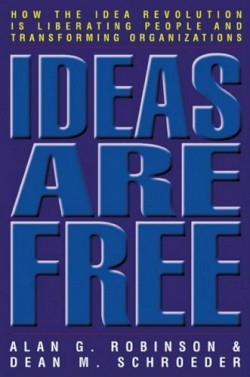Ideas are Free
How the Idea Revolution Is Liberating People and Transforming Organizations
Workers can generate ideas for improvements that are useful, even innovative. Some organizations receive and utilize employee ideas with considerable success. Many more do not. The authors undertook a years-long international study of employee ideas in business and government organizations. Their discoveries are startling: while workplace-generated ideas tend to address problems successfully, they are not widely solicited or utilized throughout industry, government, and non-profit sectors.
Many organizations simply do not seek employee ideas. Others have suggestion programs in place, but do not provide mechanisms to adopt the ideas presented; still others do promote and gather employee suggestions, but encounter implementation problems. The authors found some companies, government agencies, and non-profits where employee ideas are prolific and rapidly implemented, and make substantial positive differences in operations.
For instance, when Winnebago, the manufacturer of motor homes, found that total vehicle weight was inhibiting installation of high-margin options, CEO and founder John K. Hanson sent an open letter to employees, asking for ideas to reduce vehicle weight. “Within a month,” say the authors, “he had received more than two hundred-many of them for just a few ounces-that collectively solved the problem.” Employee suggestions quickly enhanced profitability.
The authors are both professors of management and business administration. In addition to teaching, Robinson has served as consultant to scores of companies and government agencies, and Schroeder was on the board of Examiners of the Malcolm Baldridge National Quality Award and ran successful companies. They conclude that when appropriately fostered, employee ideas in aggregate can reduce costs, add value to products and services, heighten customer satisfaction, and improve profits.
Some of their findings are counter-intuitive. For example, organizations that compensate ideas on the basis of actual costs saved, or that reward only the idea’s submitter, rather than the entire team implementing it, tend to have less successful programs. However, entities that provide few or no monetary awards for ideas, or that reward good ideas company-wide, tend to do better at developing and utilizing ideas. Another finding is less surprising: companies with high numbers of ideas per employee per year tend to show superior profits.
The straightforward prose contains examples to demonstrate the authors’ points. End-of-chapter “Key Points” and “Guerilla Tactics” sections have value, the former as good chapter summaries, and the latter as practical assistance to readers seeking to promote idea generation within their own organizations. One “Guerilla Tactic” in the chapter called “Putting the Process in Place” calls for providing extra attention to an employee’s first idea, and working with the employee to render it feasible.
This worthy study warrants close attention from organizations of all sizes.
Reviewed by
Leonard F. Charla
Disclosure: This article is not an endorsement, but a review. The publisher of this book provided free copies of the book to have their book reviewed by a professional reviewer. No fee was paid by the publisher for this review. Foreword Reviews only recommends books that we love. Foreword Magazine, Inc. is disclosing this in accordance with the Federal Trade Commission’s 16 CFR, Part 255.

